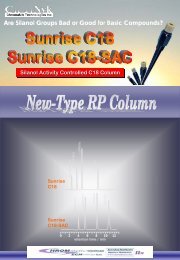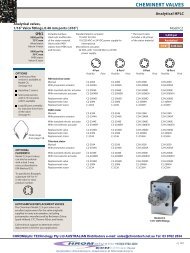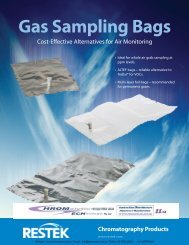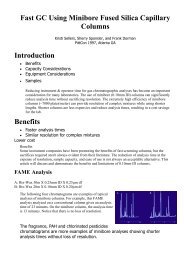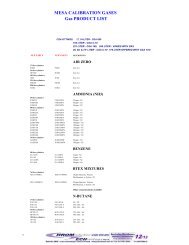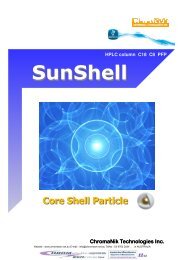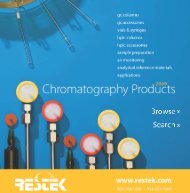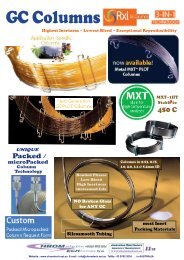GC COLUMNS | CAPILLARY COLUMNSSelecting a GC ColumnPro ezGC software will save you timeand money by greatly enhancing yourproductivity and increasing samplethroughput.Table I lists the Kovats retention indices for the more common stationary phases.Assigning a retention index to each probe listed provides a basis for comparing severalstationary phases and their relative retention to one another for a set of molecularprobes. For example, when Kovats indices are identical on two column phases, then theresulting separations will be identical. If, however, a Kovats value of one probe variessignificantly from the value on another phase for the same probe, then the resultin<strong>gc</strong>ompound elution order will differ. Thus, the Kovats indices are useful for comparin<strong>gc</strong>olumn selectivity for different types of compounds among different phases.Table I Retention indices for Restek phasesPhase Benzene Butanol Pentanone NitropropaneRtx-1 651 651 667 705For Fast GC, Windows® NT, 2000, XP, Vista,or Windows® 7 (compatibility mode).Pro ezGC Methods DevelopmentSoftware• Optimize temperature and flow programs with asingle analysis.• Reduce analysis time and improve sampleresolution.• Model retention gap and guard column applications,including Restek Integra-Guard ® <strong>columns</strong>.• Optimize dual-column run conditions, <strong>columns</strong> inparallel or in series.Take the guesswork out of selecting the best columnand conditions for your GC analysis. Pro ezGC softwareaccurately predicts separations on any capillarycolumn, and is useful for selecting a column andconditions from a single GC run. Using your retentiondata, or the extensive library, you can automaticallyevaluate thousands of combinations of column dimensions,oven temperature programs, and carrier gaspressure programs to determine the best separationwith the fastest analysis time.Pro ezGC includes a master set of retention indexlibraries at no extra charge! These libraries containmore than 3,000 compounds analyzed on the mostcommonly used stationary phases, in ten applicationareas, including pesticides, PCBs, dioxins/furans,flavor and fragrance compounds, drugs of abuse,FAMEs, semivolatile and volatile pollutants, petroleumhydrocarbons, and solvents and chemicals. Thelibraries permit computer simulation without enteringactual laboratory data.Description qty. cat.# pricePro ezGC Method DevelopmentSoftware CD-ROM ea. 21487 $201Rtx-5/Rtx-5MS 667 667 689 743Rtx-20 711 704 740 820Rtx-1301/Rtx-624 689 729 739 816Rtx-35 746 733 773 867Rtx-200 738 758 884 980Rtx-50 778 769 813 921Rtx-1701 721 778 784 881Rtx-65TG 794 779 825 938Rtx-225 847 937 958 958Stabilwax 963 1158 998 1230Retention, kThe capacity of the column relates to how much material can be injected onto a columnwithout adversely affecting peak shape. If the amount of a compound (mass) exceedsthe capacity of a column (WCOT), the peak will front, which sometimes can look likea “shark fin”. The goal is to select a column with sufficient capacity such that peak shapewill not suffer. Peak symmetry is typically used to calculate the degree of sample overload.There are two primary column-related dimensions that affect capacity, assumingthe proper column phase was selected: column internal diameter (ID) and phase filmthickness (µ).When selecting column ID, consideration should include the type of injection, thedetector being used, and the concentration of sample (amount on-column). The injectiontechnique is an important consideration because the ID of the column may needto be selected based on whether a split, splitless, cool on-column injection, or othersample transfer to the column is being used. The second consideration is the detectorand how much flow it can optimally work under. For example, some MS detectors canonly handle column flow rates of up to 1.5 mL/min.; therefore, a 0.53 mm ID column,which requires higher flows for proper chromatography, is not an option for this detector.The third consideration is sample capacity of the column. If the concentration ofthe sample exceeds the column capacity, loss of resolution, poor reproducibility, andpeak distortion will result. Table II shows several typical column characteristics forvarious column IDs.Table II Typical characteristics for <strong>columns</strong> with the same phase ratio, suchas 0.10 mm ID x 0.10 μm and 0.18 mm ID x 0.18 μm, etc.Column IDCharacteristic 0.10mm 0.15mm 0.18mm 0.25mm 0.32mm 0.53mmHelium Flow(@ 20cm/sec.) 0.16mL/min. 0.3mL/min. 0.3mL/min. 0.7mL/min. 1.2mL/min. 2.6mL/min.Hydrogen Flow(@ 40cm/sec.) 0.32mL/min. 0.6mL/min. 0.6mL/min. 1.4mL/min. 2.4mL/min. 5.2mL/min.Sample Capacity(max load per component)
GC COLUMNS | CAPILLARY COLUMNSSelecting a GC ColumnFilm thickness (µ) has a direct effect on the retention and elution temperature for eachsample component. Extremely volatile compounds should be analyzed on thick-film<strong>columns</strong> to increase the time the compounds spend in the stationary phase, allowingthem to separate. High molecular weight compounds must be analyzed on thinner film<strong>columns</strong>. This reduces the length of time the analytes stay in the column, and minimizesbleed at required higher elution temperatures. Film thickness also affects the amount ofmaterial that can be injected onto the column without overloading. A thicker filmcolumn can be used for higher concentration samples, such as purity analysis.Film thickness directly affects phase ratio (β), which is an important consideration whenchanging internal diameter. When internal diameter increases, film thickness (df) mustincrease in order to provide similar resolution and retention. Table III shows values forcommon dimensions of <strong>columns</strong>. Similar values indicate similar elution for different IDs.Table III Phase ratio (β) values for common column dimensions.*Film Thickness (df) / β ValueColumn ID 0.10µm 0.25µm 0.50µm 1.0µm 1.5µm 3.0µm 5.0µm0.18mm 450 180 90 45 30 15 90.25mm 625 250 125 63 42 21 130.32mm 800 320 160 80 53 27 160.53mm 1325 530 265 128 88 43 27*β = r/2df (r=internal radius of tubing; df = phase film thickness)Efficiency, NColumn efficiency (N) is the column length divided by the height equivalent to a theoreticalplate (HETP). The effective theoretical plates are affected by how well the phasehas been coated onto the column walls and is measured by how narrow the peaks arewhen they are eluted at the end of the column. Therefore, the higher the columnefficiency (N), the better resolution power the column will have.Capillary <strong>columns</strong> are made in various lengths, typically in standard lengths of 10, 15,30, 60, and 105 meters. Longer <strong>columns</strong> provide more resolving power, but increaseanalysis time. Doubling the column length increases resolution by approximately 41%(note: the column length is under the square root function). However, under isothermalconditions, it will double analysis time. In temperature-programmed analyses, retentiontimes are more dependent on temperature than column length, with a marginalincrease (approx. 10-20%) in analysis time upon doubling the column length.ConclusionA basic understanding of the resolution equation allows analysts to make more effectivecolumn choices. Phase choice is influenced primarily by selectivity, which can beapproximated by considering phase and analyte structures, as well as by referencingretention indices or existing applications. Column retention (capacity) and efficiencyalso affect separations and should influence decisions on column internal diameter, filmthickness, and length. By considering these factors, analysts can simplify the <strong>columns</strong>election process and increase lab productivity by optimizing separations.Restek’s Learning NetworkSign up for our widely acclaimed seminars today!Visit www.restek.com/seminarsRestek training seminars are full-day courses presented in an engaging multimediaformat. They are equally valuable to beginning chromatographers, thosewho have moderate experience and want a better understanding of the subjectmatter, and those interested in the “best practices” and latest technologies. Nosales pitch is presented, just the facts on how to make your chromatographyresults better. Visit www.restek.com/seminars for more information.www.restek.com 25Website : www.chromtech.net.au E-mail : info@chromtech.net.au TelNo : 03 9762 2034 . . . in AUSTRALIA Mar 2011



